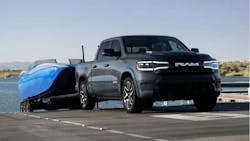EREVs: Burning Gasoline Efficiently in an EV
What you’ll learn:
- Range extenders or EREVs (extended-range electric vehicles) combine an electric vehicle’s traction battery storage system with a combustion engine and electric generator that recharges the traction battery whenever its charge falls below a specified level.
- EREVs can reduce traction battery size and weight in trade for the weight of a high-power generator and its combustion engine along with associated components like the fuel tank, exhaust system, subframe structure, etc.
- Several EREVs are scheduled to enter production in 2025-26.
The battery-electric-vehicle (xEV) market continues to expand rapidly, with global EV deliveries surging 34.6% to 4.214 million in Q1 2025. Still, the energy density constraints of advanced lithium battery chemistries fall short on delivering range exceeding 400-500 miles, or more than 200-300 miles while towing a trailer, without the vehicle becoming prohibitively heavy and expensive.
As a result, automakers are increasingly looking to what’s called the extended-range EV (EREV) to appease consumer concerns about price and range.
The name “range extender” refers to an onboard generator and internal combustion engine (ICE) integrated into the vehicle to recharge the battery when it gets depleted. Although these engines may lie under the hood, they aren't mechanically connected to the wheels. They generate electricity solely to replenish traction battery energy rather than driving the wheels.
Battery packs are big, heavy and expensive. If manufacturers can put smaller batteries in their EVs and supplement the difference with an onboard generator that creates energy to provide additional range, it would also go a long way to address about half the market that requires gasoline as the primary energy source for their vehicle.
PHEV vs. EREV
While a plug-in hybrid (PHEV) runs on both gasoline and electricity—it can drive short distances, or at low speeds, on battery power before the engine takes over—an EREV is different. It’s primarily electric, but the engine acts as a generator to extend vehicle range, usually under heavy load conditions or while towing a trailer, by charging the traction battery.
Another key difference between EREVs and PHEVs is the transmission. In most PHEVs, the electric motor is usually embedded into the transmission. In EREVs, the transmission is the same simple reduction gear mechanism found in most purely electric vehicles.
Several EREVs Scheduled for Production in 2025-26
The German company ZF recently revealed two new electric range-extender systems, which it calls the electric Range Extender (eRE) and the electric Range Extender plus (eRE+) (Fig. 1). The eRE connects an electric motor to an integrated converter with a planetary gearset. The eRE+ adds an “intelligent clutch” and a differential, which allows it to be used as a generator or a secondary drive unit.
Production is set to commence in 2026. ZF is also planning a new generation of conventional eRE systems for 2026 that only act as a generator.
By incorporating features such as intelligent clutches and differential mechanisms, ZF said it will enable these systems to be attractive for markets transitioning gradually to electric platforms.
Startup Turntide Technologies recently introduced an axial flux motor that’s also well-suited to EREV applications as a 3-phase alternator. It was covered in a recent Electronic Design Inside Electronics podcast.
One major advantage when compared to PHEVs is that the range extender ICE can be designed to run in the best rev range for peak efficiency (minimized fuel consumption and emissions). It’s less likely to produce changes in the level of emissions based on load since the traction battery charge rate can be held constant.
Scout Motors, the American SUV brand being launched by the Volkswagen Group in 2027, announced that its electric truck and SUV will also pack a range extender. Scout’s two concepts, an SUV called the Traveler and a pickup truck called the Terra (Fig. 2) will have a range of 350 miles on batteries alone and 500 miles with the optional range extender. They will feature solid rear axles and dual electric motors, with one on the front axle and one on the rear.
Another range extender, the REPB (Range Electric Paradigm Breaker), will find its way into the Jeep Grand Wagoneer (2025). It will have a combined range of 500+ miles for the Grand Wagoneer 4xe. The Grand Wagoneer 4xe is expected to share its powertrain with the Ram 1500 Ramcharger EREV (2025).
Hyundai’s EREV, debuting in 2026, will offer up to a 560-mile range. The 2025 Dodge Ram 1500 Ramcharger pickup truck goes 690 miles before needing a refuel, and as much as 145 of those miles can be purely electric thanks to a large, 92-kWh battery pack.
EREV Market Opportunity
Going forward, there may be significant opportunities for EREV sales in the United States—and in the European Union. McKinsey’s late-2024 survey of more than 2,800 new-car buyers in the United States and 2,300 in Germany and the United Kingdom found that a sizable segment would consider an EREV for their next vehicle purchase if the option were available (Source: McKinsey Center for Future Mobility, Mobility Consumer Insights, November 2024).
According to McKinsey, if the focus is on providing an electric range of 150 miles, EREV combined powertrain costs could be as much as $6,000 lower than BEV powertrain costs. In a McKinsey modeled scenario, an EREV pickup truck with a 150-mile electric range and a total range of 500 miles or more is designed using a 68-kWh lithium-nickel-manganese-cobalt-oxide (NMC) battery pack, a comparable BEV would need a 228-kWh battery pack to deliver a 500-mile range. In this scenario, an EREV powertrain could cost 30% to 40% less to produce than a BEV powertrain.
“If McKinsey is unbiased, what's been said is likely correct. The Rocky Mountain Institute’s January 2024 report says otherwise, though. It estimates 2030 cell prices at $32-$54 per kWh, which translates to complete battery pack prices of $45-$64 (call it $55) per kWh. Couple that with most EVs getting between 3-4 miles/kWh (split the baby at 3.5 mi/kWh), 500 miles of pure BEV range would need 143 kWh. Subtracting McKinsey’s 68-kWh EREV pack that’s already onboard and paid for, then 75 kWh of additional traction battery is needed, costing $4,100. Can an engine, palladium catalytic converter, exhaust system, fuel tank, and 100-kW generator be had for $4,100? Maybe. $2,400? Doubt it.”—Andy Turudic, Technology Editor, Electronic Design
At best, a non-biased analysis shows the EREV is break-even at 500 miles, but the EREV does offer the convenience of a five-minute fuel fill vs. a BEV’s 15- to 30-minute fast battery charge. The most compelling reason to produce an EREV? If all powertrains had the same specs/price, ~45% of U.S. respondents would still choose a gasoline-powered vehicle over alternatives.


